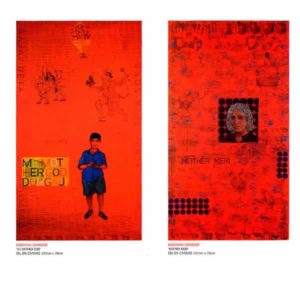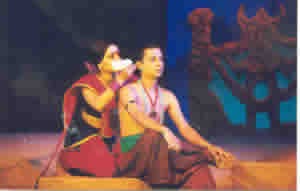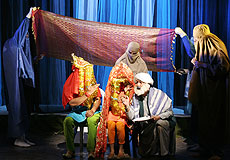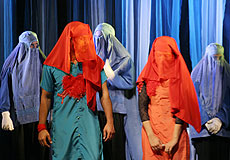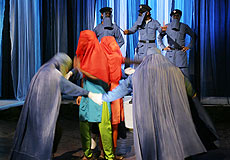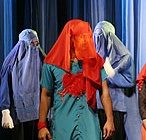India Dominates MIFF, Wins Largest Number Of Awards In International Category
by
B B Nagpal
Senior Film Critic
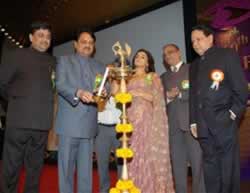

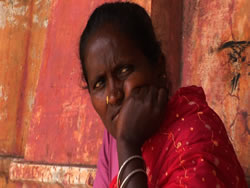
1. Maharashtra CM lighting the lamp 2. India Untouched 3. Goddesses
Makers of short or documentary films generally feel they are given the short shrift when they try to find finances for making their films, and are then treated to a step-son treatment by the government, the public service broadcaster Doordarshan, and the private television channels as far as distribution and exhibition goes. As a result, it is felt that people are no longer interested in short, documentary or animation films.
But the large number of viewers that turned up at the Tenth Mumbai International Film Festival for Documentary, Short and Animation Films were enough to prove that the medium has its own niche viewership. And the ovation that the award-winners got also showed that their judgment did not differ very much from that of the juries.
However, though every festival has some good and some bad films, the primary problem with MIFF is that the duration is just one week thus permitting only one show per film, and the number of films and variety of sections needs to be curtailed. The press conferences also could have been coordinated in a better manner since they often clashed with the film shows.
It was also necessary that while there are films that last less than a minute and others may go over one hour, the selection of films in one slot should as far as possible be of a similar kind. For example, all films dealing with wild life or all those made in animation could have been shown together. This helps the discerning viewer to decide the kind of films he or she wants to see, since all four theatres were showing different films and making a choice was often difficult.
The festival, which is held every second year by the Films Division (a media unit of the Union Information and Broadcasting Ministry) in collaboration with the government of Maharashtra and the Indian Documentary Producers Association, took place in the four theatres of the National Centre for the Performing Arts at Nariman Point in Mumbai from February 3 to 9.
A total of 235 films were shown in the special packages in the festival. In addition, there were 44 films in the International Competition from 16 countries, 54 films in the Indian competition, and 13 international and nine Indian films in special screenings. Films from a total of 37 countries were screened in different sections.
Renowned Manipur filmmaker Aribam Syam Sharma received the V Shantaram Award for Lifetime Contribution from Kiran Shantaram amidst a standing ovation. The award carries a shawl, a citation, and a cash component of Rs 2,50,000.
Sharma is a film director, actor, critic, and music director. He came to limelight with his award winning film ‘Imagi Ningthem’ (My son, My Precious) that received the grand Prix at International Film festival at Nantes in France in 1982. His other acclaimed films include ‘Ishanou’, the official selection (un Certain Regard) for Cannes Film Festival 1991, and ‘Sangai-The Dancing Deer of Manipur’ declared as the “Outstanding Film of the Year 1989” by the British Film Institute. He has directed nine Manipuri feature films and 26 non feature films. They include ‘Sanabi’ (The Frey mare) in 1996, ‘Rajarshee Bhagyachandra of Manipur’, and ‘Gurumayum Nirmal’. He has won numerous national awards and also chaired many juries.
Indian films bagged the top award – the Golden Conch – for best documentary in both the national and international categories even as it bagged four other awards in the international category at the Festival.
While ‘India Untouched – Stories of a People Apart’ by Stalin K. based on the oppressive caste system got the top award in the Indian section (Rs 1,50,000), ‘Goddesses’ by Leena Manimekalai on women’s emancipation received the Golden Conch in the international section (Rs 2,50,000) for films up to sixty minutes.
‘India Untouched’ also won the award of Rs 100,000 for best film/video of the Festival for the Producer Drishti – Media, Arts and Human Rights.
In ‘Goddesses’, the young filmmaker tells the story of three old material goddesses who for different reasons find themselves naturally emancipated from Tamil tradition and orthodoxy. Leena creates a trusting filming arena that was never manipulative so that the three women opened up and revealed their total strength and power bordering on the archetype. They emerged free, master of the very tradition that had earlier kept them shackled.
‘India Untouched-Stories of a People’ not only achieves the ideals of socially and politically committed documentary film making, but unflinchingly uncovers the all pervasive, deeply rooted and still existing caste system in twenty first century India, with chilling evidence that it shows no sign of abating in generations to come. In fact, the Jury recommended the film as essential viewing for all audiences worldwide, adding that the film is in the best tradition of documentary film making and is an inspiration to all filmmakers for independent, thought-provoking, free-spirited use of the medium for social change.
The film’s producer Drishti – Media Arts & Human Rights won the award for taking the initiative and having the courage to investigate the issue of untouchability and its ramifications in all corners of Indian society.
The awards were given away on 9 February in Tata Theatre by Festival Director and Films Division Chief Producer Kuldeep Sinha, filmmakers Shyam Benegal and Jahnu Barua, and actress Nandita Das in a ceremony conducted by television actress and presenter Rajeshwari Sachdev.
The other Indian films to win awards in the international category were: ‘Kramasha’ by Amit Dutta which won the best fiction up to 75 minutes (Golden Conch and Rs 2,50,000) and the Producer’s Award for the Film and Television Institute of India (Rs 100,000), ‘Ink’ which was the first best film by director Bharani Thanikella (Trophy and Rs 100,000), and ‘Undertakers’ by Emannuel Quindo Palo which shared the award for second best fiction film up to 75 minutes with Belgium’s ‘Bare Handed’ by Thierry Knauff (Silver Conch and Rs 100,000).
In ‘Kramasha’, the music keeps one quietly enthralled with a resonating sense of things without a need to necessarily reduce the experience to a verbalization of meanings. The film shows a world of images and sounds that make one smell and touch the lush of nature amid a mysterious index of hallucinations. Like a dream that one may fail to understand but that reaches deep recesses of the unconscious and touches familiar chords, this film by Amit Dutta weaves a powerful narrative that blends legends, myths and nostalgia into a film that allows us to recall one’s early experiences.
Emannuel Quindo Palo’s ‘Undertakers’ manages to distance the viewer from the narrative and create a moving account of a Catholic coffin maker whose business is death but whose dead friends can claim free coffins. The absurd idiom of the film draws a humane picture of the struggles of an ordinary salesman who appears strangely caught between his survival and personal ethic.
Through surreal imagery, Bharani’s ‘Ink’ was able to employ a violent visual idiom for existential struggle of the poet, and the fight he wages against violence of terrorism. In this film which is full of resilience, the poet’s wife deeply worried about their lives takes on the mantle of fight against terrorism after the poet’s death.
Just the manner in which the dancer in Knauff’s ‘Bare Handed’ handles the newspaper and the noise caused by it to strangely reveal the violence a newspaper and therefore the world around us may carry. But it is the dancing woman whom a verbal world threatens to contain. In a series of deft choreographed movements and an equal graphic light the film makes the dancer dance her way through memories and desires until after a complete immersion in this world she loses herself in it.
Poland, the United States, and Egypt won two awards each in the international section. Two Polish films ‘One day in People’s Poland’ by Maciej J. Drygas and ‘Beyond the Wall’ by Vita Zelakeviciute, both produced by Drygas, shared the award for Second Best Documentary up to sixty minutes duration (Silver Conch and Rs 100,000). ‘Salata Baladi’ (House Salad) by Nadia Kamel of Egypt got the Golden Conch and Rs 2,50,000 for best documentary above 60 minutes and the international critics FIPRESCI award (Certificate of Merit). The two American films to win awards were ‘Flow: for love of water’ by Irena Salina got the FIPRESCI award and Rs 100,000, and ‘View from a Grain of Sand’ by Meena Nanji which won the second best documentary film above sixty minutes (Silver Conch and Rs 100,000).
September 27, 1962 was an ordinary day in Poland except for its reconstruction by Drygas in the film ‘One Day in People’s Poland’. The archival images and sounds retrieved from several sources obviously do not synchronize to a singular reality. Without an effort to force a historical realism upon the material, the director keeps the two tracks independent, making them move closer and further away from each other, creating an extraordinary document that is startling in its revelation of the nature of surveillance the state maintained in the sixties by keeping account of banal and inconsequential details in the daily life of its suspect citizens. The enormous task of editing the monumental archival material has been handled very competently.
‘Beyond the Wall’ uses short and pure images that elude description. Through this poetic procedure, the director directly enters into a hazy universe of Russian soldiers sent to prison hospital to serve their sentence. The nondescript events such as the walks, the meals, the medicines, the crowding of the cell generate an unforgettable poem of silence and depth in confinement. Vita Zelakeviciute’s narrative of broken spirits is a reflection on cold and heartless systems mankind is able to set in place in governance of countries.
‘Salate Baladi’ breaks down the classical cinema composition and makes a film deeply insightful of history. It makes geographical borders between countries appear unnatural, incapable of constricting families from their extensive affinities. The metaphor is no longer the family tree rooted in local soil – it is closer to a multiplicity in the manner the grass grows.
Faced with an environment where women are oppressed to the extreme, Meena was able to make her characters in ‘View from a Grain of Sand’ feel safe for them to candidly re-evaluate their condition under the Taliban and post-Taliban periods in Afghanistan. Even as they put themselves to risk they are prepared to boldly share their knowledge and experience with the filmmaker.
The FIPRESCI jury decided to characterize its Award as recognition of films that bring unknown shocking revelations that threaten ecological and even existential balance of planet Earth. The depiction of a global crisis caused by privatization of natural resource such as water in the film ‘Flow: Love of Water’ attempts to educate the audience of atrocities major corporations commit against individuals, families and communities in the name of water and for the sake of plain old profit. The message of the film is clear: make water free, clean and available to the citizens of the world. The revealing research Salina conducted was exemplary.
In the Indian section, the Golden Conch and Rs 1,50,000 also went to best fiction ‘Manjha’ by Rahi Anil Barve who also got the award for best first film of a director (Rs Trophy and Rs 25,000), and best animation film ‘Myths about you’ by Nandita Jain. Other awards included Indian Jury Award (Rs 100,000) which went to two films: ‘I’m very beautiful’ by Shyamal Kumar Karmakar and ‘Thousand Days and a Dream’ by P Baburaj and C Saratchandran, the Indian Critics award to ‘Mahua Memoirs’ by Vinod Raja which also received the award for second best documentary (Silver Conch and Rs 75,000).
‘Mahua Memoirs’ compassionately exposes the ruthless underside of corporate globalization through the ongoing decimation of Adivasi lands, people and their cultures throughout India. Crafted with outstanding visuals and haunting music, it is an urgent call to re-examine the policies of the day.
In ‘Manjha’, the first-time director Rahi Anil Barve’s fictional expression of child sexual abuse and survival has been portrayed in a highly individualistic, graphic and cinematic style. The filmmaker manages to extract outstanding performances from the actors within a stark, industrial urban landscape. The film is also laudable for the understanding of cinematic form and idiom and having the courage to push the form to tell a difficult story.
‘Myths About You’ is a clever and imaginative representation of the history of the Universe, both in terms of Hindu mythology and scientific research, in an original graphic style, all within a short span of 9 minutes.
‘I’m the Very Beautiful’ is a personal, complex and often contradictory portrait of an indomitable woman and her continuous struggle in her pursuit of a life of freedom and dignity despite her social stigma in a patriarchal and chauvinistic society. In its style and treatment, the film mirrors the free spirit of the protagonist with abandon and candour.
‘Thousand Days And A Dream’ tells the poignant and dramatic story of the peaceful struggle of common people against a gigantic multinational company supported by the policies of the state in which the people have been deprived of their vital, basic natural resources and livelihood.
The Silver Conch and Rs 75,000 for second best films also went to ‘The Lost Rainbow’ by Dhiraj Meshram produced by FTII (fiction up to 75 minutes) and animation film ‘Three Little Pigs’ by Bhavana Vyas and Akarito Assumi.
‘The Lost Rainbow’ presents a series of nostalgic, touching moments in an evocative and playful manner, enhanced by the realistic performances of the child actors. The film details how the results of mischievous sibling rivalry can haunt the protagonists for the remainder of their lives.
‘Three Little Pigs’ is a well-known childhood story made through wire frame animation techniques in a deceptively simple style. The film has background voice-overs in the form of a conversation recalling the story, which is both engaging and amusing while bridging the documentary form with animation.
Special Mention and Certificate of Merit was awarded to two films: ‘Our Family’ by Dr K P Jayasankar and Dr Anjali Monteiro, and ‘Raga of River Narmada’ by Rajendra Janglay.
‘Our Family’ is a compassionate and sensitive portrayal of the third sex – their bonding and their aspirations. The film traces their roots sourced from mythology combined with a mesmerizing one-person performance of the traumas and stigma experienced by their community.
‘Raga of River Narmada’ has fascinating flowing visuals highlighting the river in its many vibrant moods through its journey complemented by an exceptional use of the Dhrupad.
Apart from the main sections, there were sections like ‘Best of Festivals’ for selected films from some renowned documentary, short and animation film festivals and Oscar winning and nominated films, a retrospective of films by jury members, a section of Classics featuring films of great masters of documentary films which will have films made by Great Masters like Bert Haanstra, Robert J. Flaherty, Francois Truffaut, Istvan Szabo, Kristof Zanussi and Ritwik Ghatak. This package was organized with the support of National Film Archives of India. A Film Memoir showed biographical films made on great filmmakers like Andrei Tarkovsky, Ingmar Bergman, Satyajit Ray, and Bimal Roy
There was a special and rarely seen section on films on the Second World War with rarest film records of the Indian troops in action at various part of the world during Second World War. This will also feature the battle of Britain, Russia and other major incidents of that period. This package was put together with the help of the Armed Forces Film & Photo Division, Delhi.
There were sections for films from the North East and from Jammu and Kashmir, and Glimpses from the archives of the Division, apart from homage to filmmakers who passed away in the recent past.
Unfortunately, most of the films which won awards are unlikely to be shown anywhere, since Doordarshan shows the films at unearthly late hours and the Government is still not taking a decision on a proposal by the Films Division for a separate documentary channel. The NDTV recently commenced showing documentaries once a week, but all this is hardly enough.
It is high time that the Information and Broadcasting Minister Mr Priyaranjan Dasmunsi loves up to the promise he made on the opening day of MIFF that he would clear any proposal for a documentary channel within five days. With the new advent of short features and amusing animation, even a documentary channel is bound to find sponsors and become commercially viable
